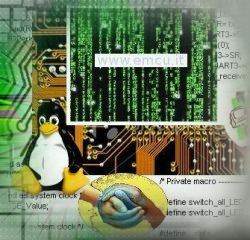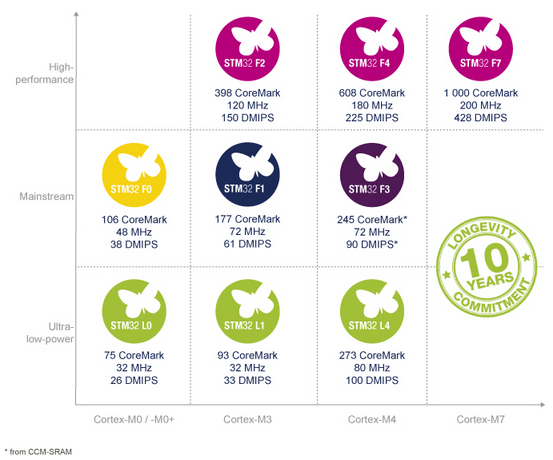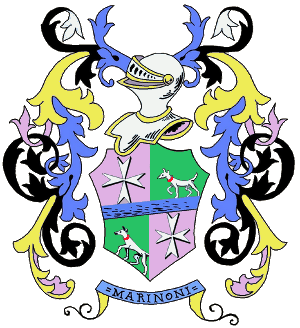

|
|||||||
|
|
|
|
Microcontroller
& C STMicroelectronics
video on YouTube
Presentations, Tutorials, Exhibitions
and more...
Product news from
STMIn this section you will find the
latest news from STM.
Marketing presentations from STM and SILICA are here STM Studio STM
Studio helps debug and diagnose STM8 and STM32 applications while they
are running by reading and displaying their variables in real-time.
STM32 Cube STM32 pin allocation, code generator and more that
substitute the MicroXplorer.
STM brochure & flayer STM8 ST's
8-bit microcontroller platform is implemented around a high-performance
8-bit core and a state-of-the-art set of peripherals.
Performance: @24MHz - 6 DMIPS - 5 CoreMark The STM8 platform supports three main product lines: STM8S,
general-purpose MCU
EvaBoard for STM8 DALI is hereSTM8L, ultra-low-power EnergyLite™ MCU STM8A, automotive MCU STM8AL, automotive ultra-low-power MCU STM32-STM8 embedded software solutions (update to January 2012, pdf 1.9MB), is here. STM32 The
STM32 family of 32-bit Flash microcontrollers is based on the
breakthrough ARM Cortex™ M0, M3, M4 and M7 core featuring architectural
enhancements with the Thumb-2 instruction set to deliver improved
performance with better code density, significantly faster response to
interrupts, all combined with industry-leading power savings. It offers
a complete 32-bit product range while maintaining full integration and
ease of development.
STM32 and STM8 MCU
Longevity CommitmentIn addition, STM every day works to improve the STM32 EcoSystem. The STM32 main product lines: STM32F7xx, very high performance MCU + TFT
controller - Cortex
M7
STM32F4xx, general-purpose MCU + TFT controller - Cortex M4 STM32F3xx, for analog applications MCU - Cortex M4 STM32F1xx & STM32F2xx, general-purpose MCU - Cortex M3 STM32F0xx, general-purpose MCU - Cortex M0 STM32L4xx, ultra-low-power EnergyLite™ MCU - Cortex M4 STM32L1xx, ultra-low-power EnergyLite™ MCU - Cortex M3 STM32L0xx, ultra-low-power EnergyLite™ MCU - Cortex M0+ 
STMicroelectronics
provides a minimum longevity commitment of 10 years for its below
listed STM32 ARM® Cortex®-M and STM8 microcontrollers.
STM32 & STM8 product finder app for smartphone & tablet is here STM32 training courses (for Europe) see here Evaluation Boards for STM8 & STM32 are here SPEAr embedded MPUs (ARM9 & CORTEX A9) SPEAr®
eMPU family are 32-bit ARM® ARM926EJ-S or Cortex-A9 based devices for
cost-sensitive applications requiring significant processing and
connectivity capabilities at lower power consumptions.
SPC5 - 32-bit family for automotive (Power PC) The
SPC56 family of 32-bit automotive microcontrollers is designed using
Power Architecture™ and ST’s 90 nm embedded Flash technology. Developed
within the framework of the STMicroelectronics/Freescale Joint
Development Program (JDP), it combines a scalable range of 200 cores
with innovative peripheral sets that are optimized for building
efficient applications in engine management, chassis, safety, body
control and instrument clusters.
STR9 ( WebServer ) Introduction to Networking and
Ethernet (TCP, IP, UDP, etc) in English is here
(pdf)
Introduzione al Networking e a Ethernet (TCP, IP, UDP, ecc) in Italiano è qui (pdf) Xpander Xpander
devices are general-purpose input/output port expanders to interface
digital ASICs via a two-line bidirectional bus (I²C). Intelligent
features offered by Xpander logic include an advanced matrix keypad
controller supporting up to 96 keys and an advanced PWM controller
providing complex brightness pattern control.
ST-LINK & ST-LINKv2 The ST-LINK is an in-circuit debugger and programmer for the STM8 and STM32 microcontroller families.
The SWIM
and JTAG/SWD interface is used
to communicate with the STM8 or
STM32 microcontroller located on your own application board.
DLL for STVP STVP is: ST Visual Programmer for
programming ST7, STM8, STM8T and STM32.
If you need to customize the STVP is possible using DLL package (for Windows), for more info see here. Other components
Various
Funny BLINK(1)
 TOR a way to surf, share data and more, on Internet with a secret identity. NINUX is an alternative model to the development of telecommunications networks, a model based on sharing, cooperation and freedom, in accordance with the philosophy of free software. Serval Mesh for ANDROID Phone How
to solder the TQFP, see below.
C Compiler Python
RaspBerry Pi Linux & C
INTERNET, ADSL & C
ANDROID iPad Packard Bell DOT M/A General Pourpose Free Time Our
friends  Si dice che ci vuole un minuto per notare una persona speciale, un'ora per apprezzarla, un giorno per volerle bene, ma poi tutta una vita per dimenticarla. They say it takes a minute to notice a special person, an hour to appreciate it, a day to love her, but then an entire life to forget her. Non-Profit Association that help families in difficulty 2014 Informativa estesa su Attività - Cookie - Privacy Go on TOP |
|
|
|
||

By: Enrico Marinoni
| Site Map |


























